
Japanese Wedding Jewlery
Explore the intricate world of traditional Japanese wedding jewelry, including the elegant Kanzashi hair ornaments, the artistic Obidome sash clips, and the timeless beauty of Akoya pearl jewelry. Discover the cultural significance and craftsmanship behind these stunning adornments.

The Elegance of Traditional Japanese Wedding Jewelry
Jewels of Tradition
Japanese weddings are a beautiful confluence of cultural heritage and exquisite artistry, where every detail is imbued with meaning and tradition. This is particularly evident in the jewelry worn by brides. From the delicate Kanzashi hairpieces, to the sophisticated Obidome sash clips that secure the obi with grace, and the lustrous Akoya pearls that exude timeless beauty, each piece tells a unique story. These traditional adornments are not merely decorative; they are steeped in symbolism and cultural significance, representing virtues, blessings, and the hopes of a prosperous marriage. Let’s delve into these stunning pieces of jewelry, their history, craftsmanship, and the important roles they play in Japanese wedding traditions.
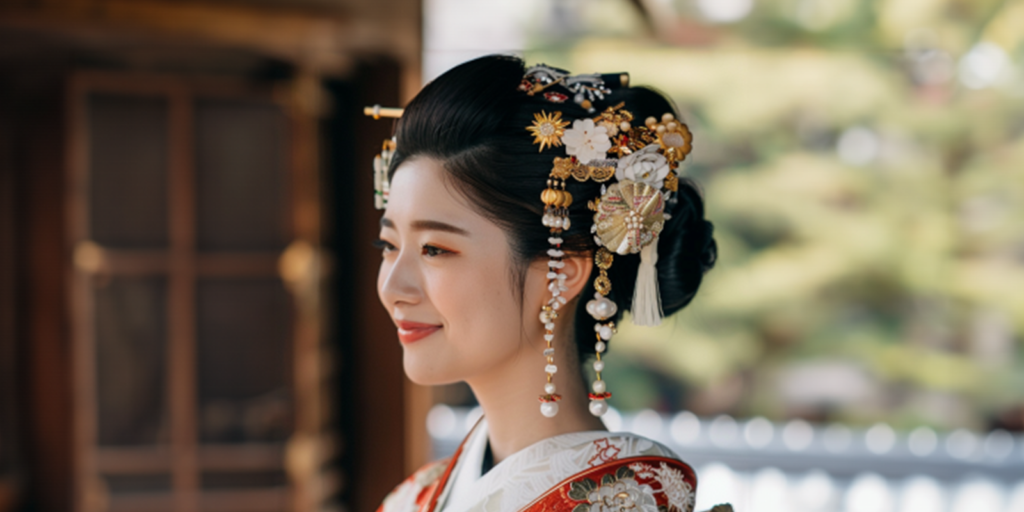
Kanzashi: The Art of Hair Adornments
History and Craftsmanship
Kanzashi are traditional Japanese hair ornaments with roots dating back to the Jomon period, around 14,000 BCE. Crafted from materials like lacquered wood, gold, silver, tortoiseshell, and silk, these pieces showcase exquisite artistry and craftsmanship.
Kanzashi designs often feature motifs such as flowers, butterflies, and cranes, each symbolizing different virtues and blessings. Cherry blossoms (sakura) represent the beauty and transience of life, while butterflies (cho) symbolize transformation and hope. Cranes (tsuru), especially significant in bridal Kanzashi, signify longevity, good fortune, and fidelity. These motifs not only enhance the aesthetic appeal but also imbue the ornaments with deep cultural and spiritual significance, making Kanzashi a treasured part of a bride’s wedding attire.
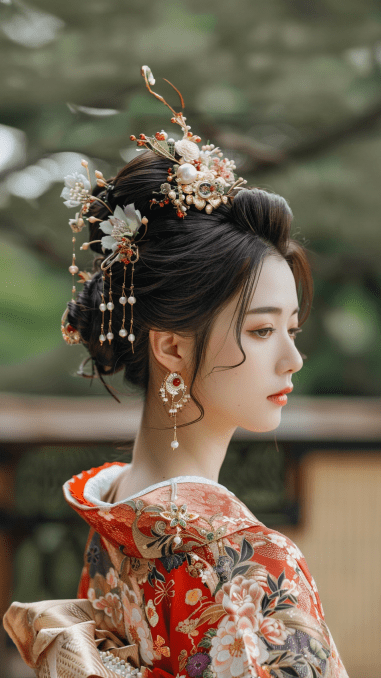
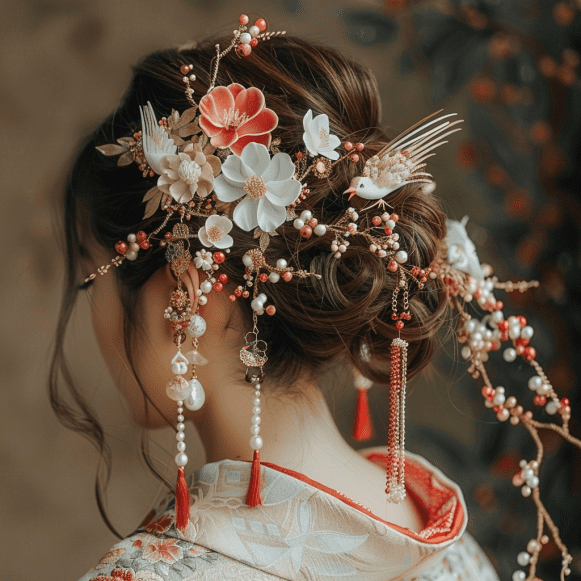
Symbolism in Weddings
In traditional Japanese weddings, the bride’s hairstyle is meticulously crafted, with Kanzashi playing a pivotal role in enhancing her appearance. Brides may wear a full set of Kanzashi, including bira-bira (dangling ornaments) and tama-kanzashi (bead hairpins). These ornaments are not just decorative but also signify different stages of the wedding ceremony, adding layers of meaning and elegance to the bridal ensemble.
Obidome: The Elegant Sash Clips
Design and Materials
Obidome are small, intricately designed decorative clips worn with the obi, the wide sash fundamental to traditional Japanese kimono attire. Serving both functional and aesthetic purposes, they secure the obi while adding refined beauty to the ensemble. Often crafted from precious materials like jade, coral, gold, silver, lacquer, or enamel, Obidome reflect high craftsmanship and value. Their designs feature varied and detailed motifs such as delicate flowers, graceful animals, and traditional patterns, each with symbolic meanings. For example, plum blossoms symbolize resilience and renewal, cherry blossoms represent fleeting beauty, cranes signify longevity and good fortune, and butterflies denote transformation and hope. Imbued with cultural and symbolic significance, Obidome are cherished parts of traditional Japanese attire, especially at weddings, reflecting the wearer’s status, taste, and Japan’s cultural heritage, adding depth and meaning to their beauty.


Role in Weddings
In the context of a Japanese wedding, Obidome are more than just fashion statements; they symbolize the bride’s elegance and refinement. These decorative clips, chosen with great care, feature motifs with auspicious meanings. Pine trees represent steadfastness and longevity, plum blossoms symbolize resilience and renewal, and bamboo signifies strength and flexibility. Each motif is thoughtfully selected to reflect the couple’s hopes for a strong, enduring marriage. By incorporating these symbolic elements, Obidome enhance the aesthetic beauty of the bride’s attire and imbue it with cultural and emotional significance. This thoughtful selection highlights the bride’s appreciation for tradition and her desire to convey heartfelt messages through her ensemble, making the Obidome a treasured piece that enriches the wedding experience.
Akoya Pearls: Timeless Elegance
Cultivation and Characteristics
Akoya pearls, renowned for their exceptional luster and perfectly round shape, are a favorite choice for bridal jewelry in Japan. Cultivated in the Akoya oyster found in Japan’s coastal waters, particularly in Ise-Shima and Kyushu, these pearls result from a meticulous process where a small bead and mantle tissue are implanted, creating the pearl over several months to years. The result is a pearl with stunning iridescence and a classic white color, often with rose, silver, or cream overtones. Symbolizing purity, elegance, and sophistication, Akoya pearls enhance a bride’s appearance, adding refined grace to traditional wedding attire. Worn as necklaces, earrings, or bracelets, they are treasured for both their aesthetic appeal and cultural significance, representing the bride’s purity and the timeless beauty of the ceremony. Their enduring quality makes them sentimental heirlooms, often passed down through generations, enriching their value in Japanese bridal traditions.
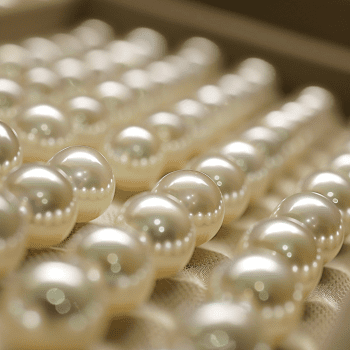
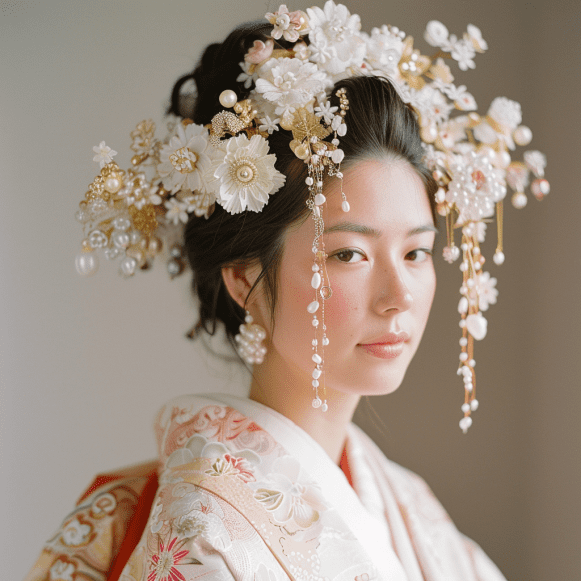
Significance in Weddings
A bride wearing Akoya pearl jewelry on her wedding day embodies timeless beauty and sophistication. These pearls are commonly seen in necklaces, earrings, and bracelets, complementing the traditional white wedding kimono, known as the shiromuku. The pearls’ natural glow enhances the bride’s radiance, creating a harmonious and refined look that bridges tradition and contemporary style. Often passed down through generations, Akoya pearls add sentimental value to their aesthetic appeal.
Other Traditional Pieces
Tsumami Kanzashi
Tsumami Kanzashi are a specific type of Kanzashi made from small, square pieces of silk. These pieces are folded and assembled into intricate floral designs, often resembling cherry blossoms or chrysanthemums. Brides wear Tsumami Kanzashi to add delicate and detailed beauty to their hairstyles, symbolizing femininity and grace.
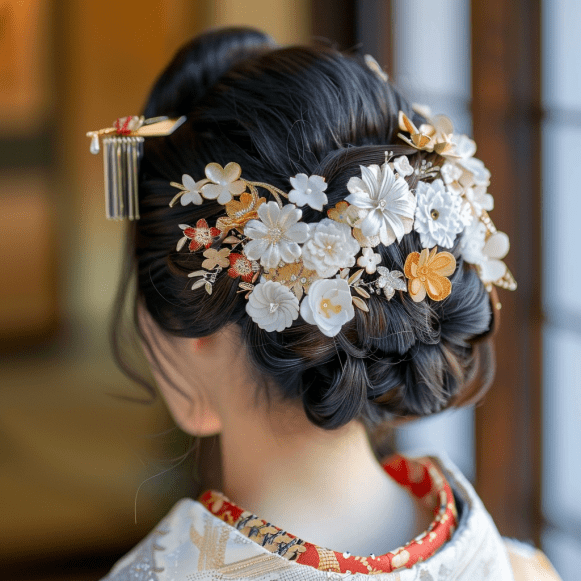
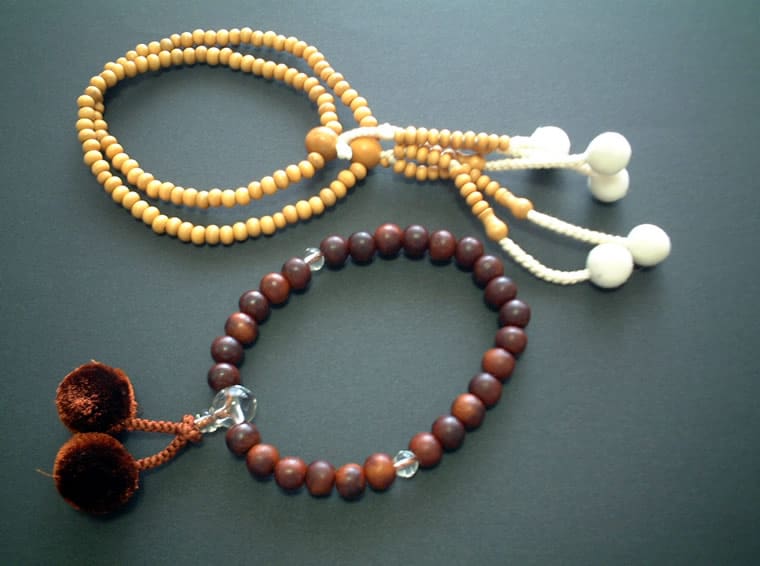
Juzu Beads
Juzu beads, also known as Buddhist prayer beads, are sometimes incorporated into bridal jewelry for their spiritual significance. Made from materials like wood, crystal, or precious stones, Juzu beads are worn as bracelets or necklaces, adding a touch of spiritual depth to the bridal ensemble.
Celebrating Japanese Bridal Jewelry
Traditional Japanese wedding jewelry is a testament to Japan’s rich cultural heritage and exceptional craftsmanship. For brides looking to honor their heritage or simply appreciate the beauty of Japanese artistry, these pieces provide a perfect blend of cultural significance and aesthetic appeal. While you’re still here, if you have a traditional Japanese jewelry piece that needs a repair, you can be sure to trust it to the hands of our Master Craftsmen right here at My Jewelry Repair

Check Out the Magic of Our Jewelry Services!
Resources:
- Juzu:https://commons.wikimedia.org/
- The Traditional Japanese Art of Shibuichi:https://www.jaumelabro.com/a>
